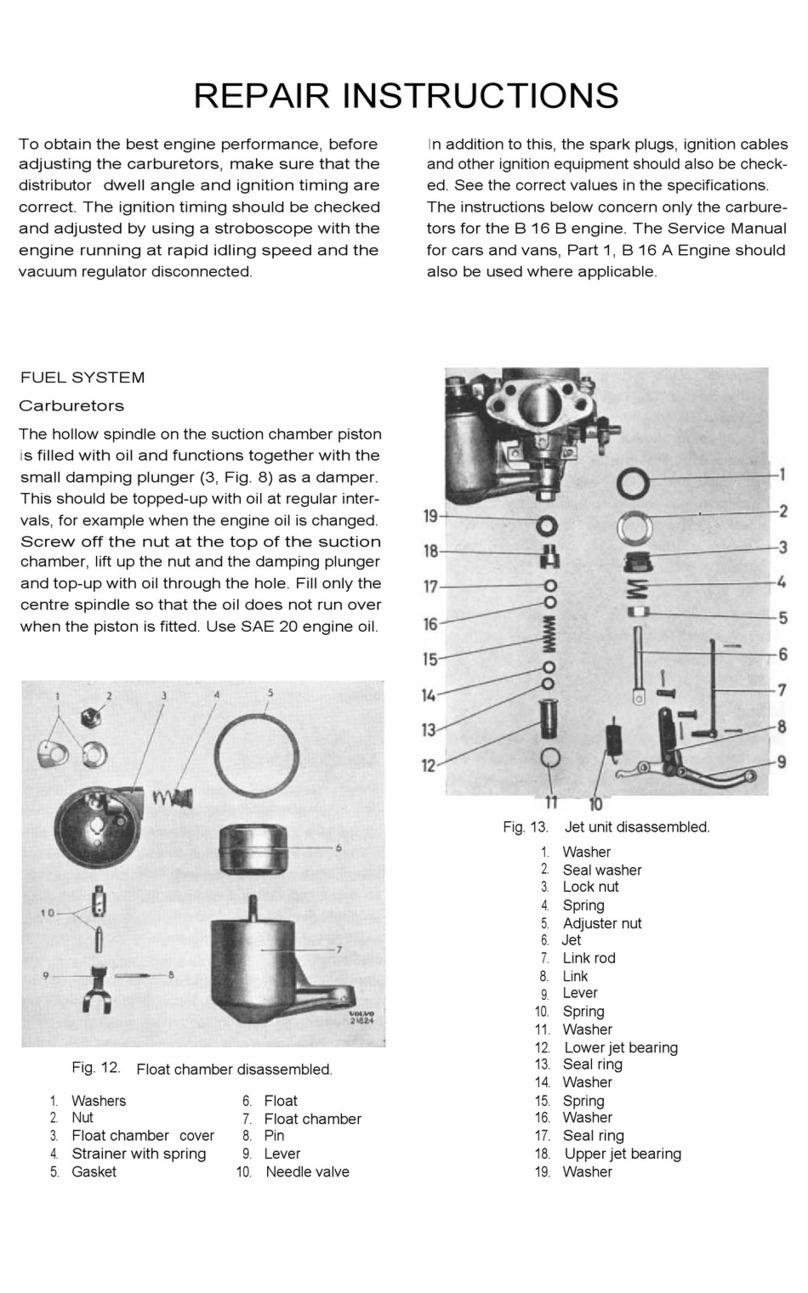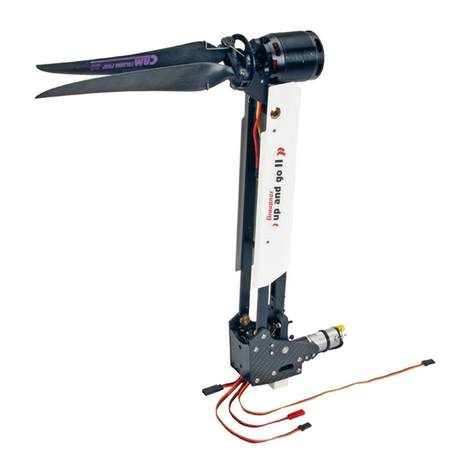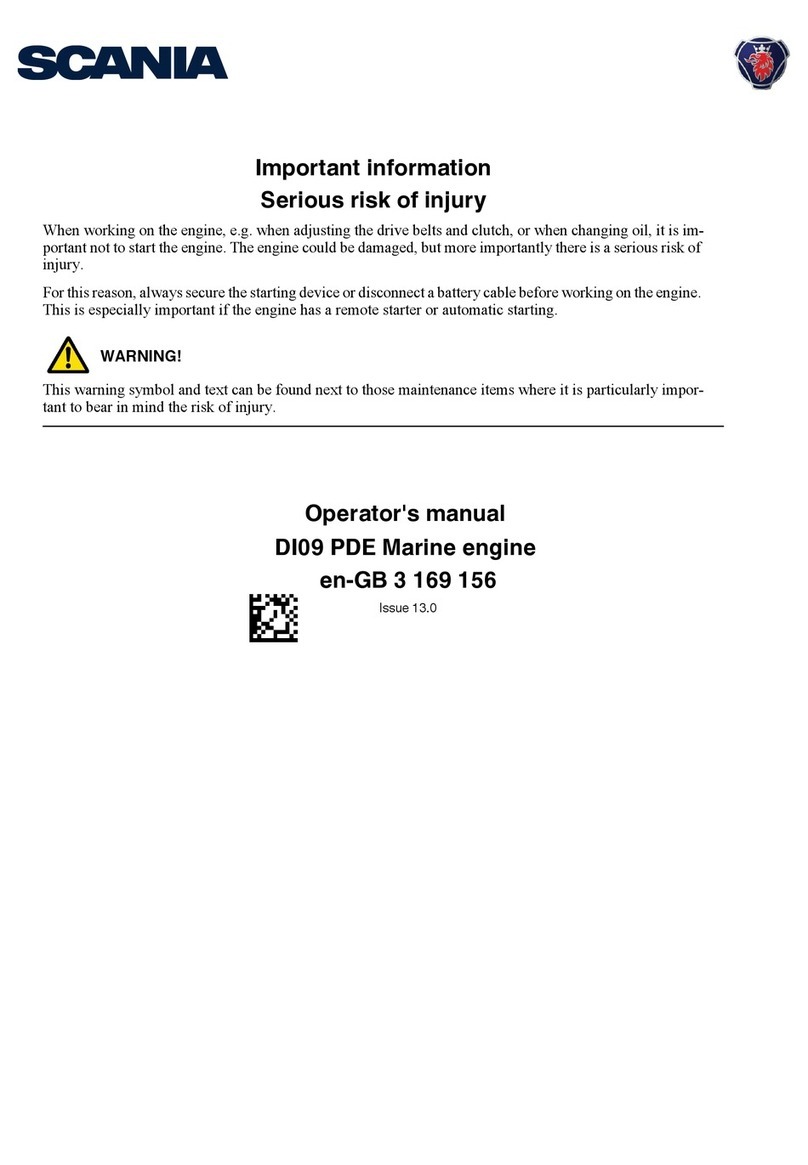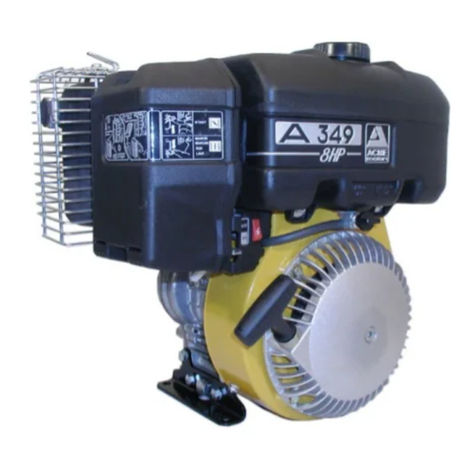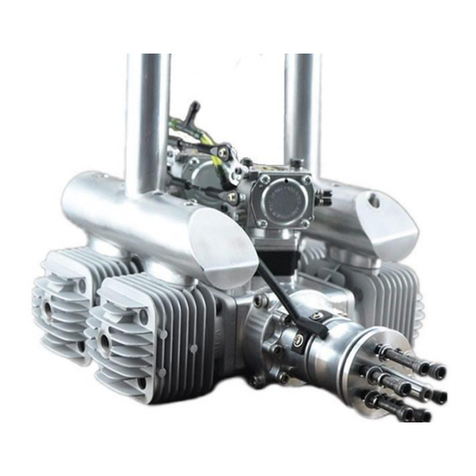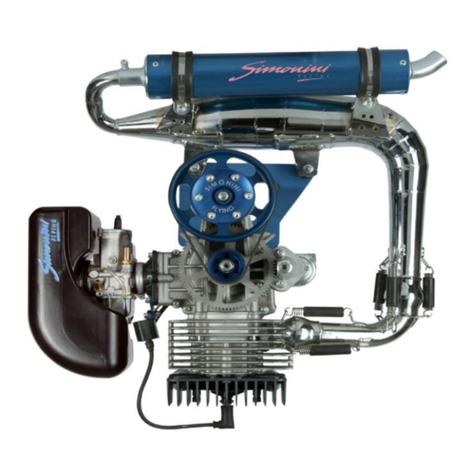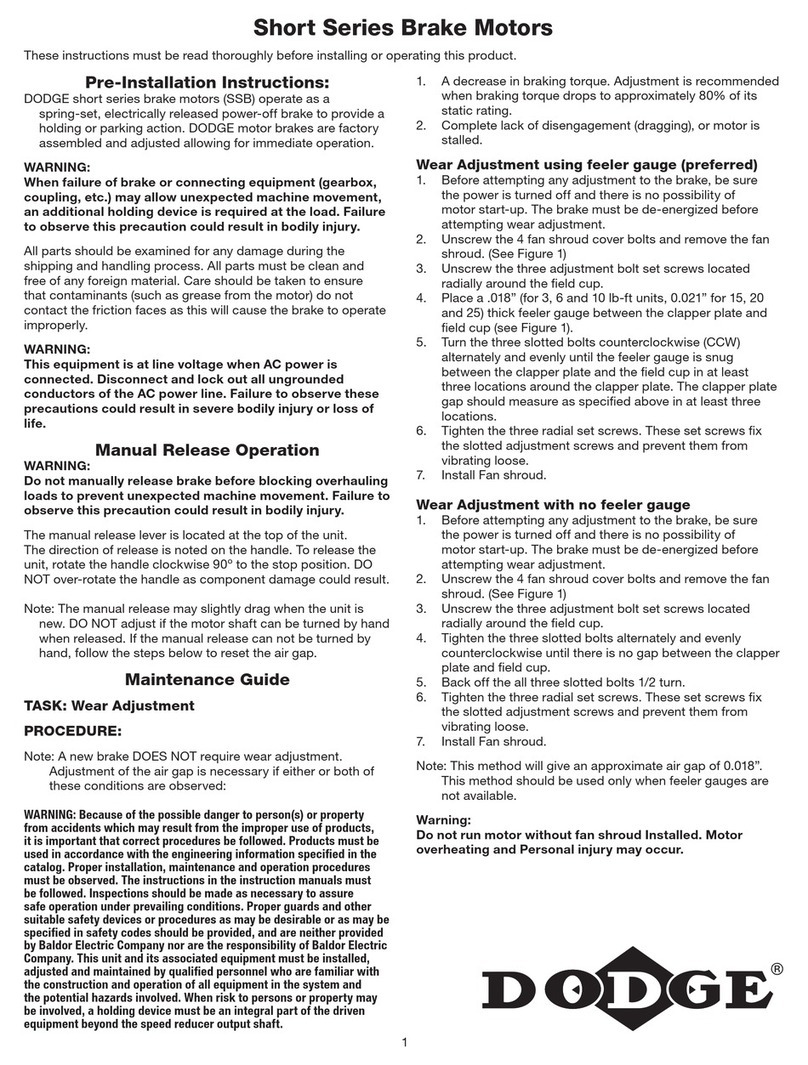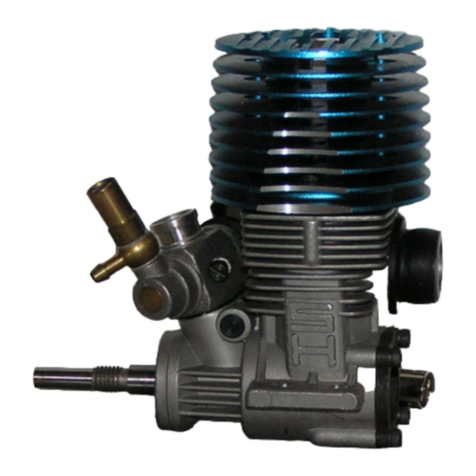Hino J05E-TH Instruction manual

HINO DIESEL ENGINE
WORKSHOP MANUAL
J05E-TH
(HS ENGINE for 25t)
2007.6
KSS-SMJ5-E111E


1
2
3
4
5
6
7
8
9
10
11
12
13
14
15
16
17
GENERAL
STANDARD VALUE
ENGINE ASSEMBLY/DISASSEMBLY
FUEL SYSTEM
EMISSION CONTROL
ELECTRICAL
INTAKE
ENGINE MECHANICAL
EXHAUST
COOLING
LUBRICATION
STARTING AND CHARGING
TURBOCHARGER
FAILURE DIAGNOSIS FOR EACH ENGINE STATUS
ENGINE DIAGNOSIS CODE
PARTS TO BE PREPARED
AIR COMPRESSOR
For your information:
This documentation does not contain any descriptions in
regard to the hatched part
"6. Emission Control".
"15. Air Compressors".


GENERAL 1–1
1
ENGINE
1 GENERAL
GeneralGeneral information
Warning................................................................... 1-2
How to read this manual ........................................ 1-3
Precautions for work ............................................... 1-7
Tightening of engine bolts and nuts...................... 1-10
Tightening of chassis bolts and nuts..................... 1-12
Tightening of flare nuts and hoses........................ 1-14
Taper thread sealant for piping ............................. 1-15
Assembly of joints and gaskets for piping............. 1-16
Handling of liquid gasket....................................... 1-18
Failure diagnosis table for each problem .............. 1-19
Failure diagnosis using HinoDX............................ 1-20
Connection method of HinoDX ............................. 1-23
Chassis number and engine number ................... 1-23

GENERAL1–2
Warning
JP31199010102001
Observe the following precautions to work safely and to prevent damage to customers' vehicles.
This manual is prepared for qualified service engineers who are recognized as technical expert. Those who are not
qualified, who are not appropriately trained, who performs service without appropriate tool or equipment, or who
perform service with the way not specified in this manual may not only damage the vehicle, but also put service
engineers and surrounding people in danger.
•Appropriate service and repair are essential to ensure safety of service engineers and safety and reliability of
vehicles. Be sure to use Hino genuine parts for replacement of parts. Do not use deteriorated parts in quality.
•Items described in this manual are the procedures to be observed in service and repair. For service and repair
according to this procedure, be sure to use the special tools designed for each purpose.
•If a method or a tool not recommended is used, safety of service engineers, and safety and reliability of vehicles
may be impaired. Never use a method or tool not recommended.
•This manual shows “Warning” and “Caution” for items that need to be observed so that accidents may not occur
during service or repair, or that damage to vehicle due to improper method may not impair safety and reliability of
vehicles. These instructions cannot give warning for all possible hazards. Note that items with “Warning” or
“Caution” are not absolute for safety.

GENERAL 1–3
How to read this manual
JP31199010102002
1. Scope of repair work
(1) Repair work is classified into three large categories of "Diagnosis", "Mounting/removal, replacement,
assembly⋅disassembly and inspection⋅adjustment" and "Final inspection".
(2) This manual describes "Diagnosis" in the first process and "Mounting/removal, replacement,
assembly⋅disassembly and inspection⋅adjustment" in the second process. Explanation of "Final inspection"
in the third process is omitted here.
(3) Although the following work is not described in this manual, it should be performed in actual work.
a. Jacking and lifting
b. Cleaning and washing of removed parts as required
c. Visual inspection
2. Standard value
(1) Standard value, limit, action and tightening torque described in the text are summarized in tables.
3. Items to be prepared
(1) Items to be prepared before work are SST, tools, gauges and lubricant, etc. These are listed in the list
section of items to be prepared. Items such as general tools, jack, rigid rack, etc. that are usually
equipped in general service shop are omitted.
4. How to read sections and titles
(1) Sections are classified according to J2008, SAE standard.
(2) For areas that show system names like "Engine control system", "Inspection", "Adjustment",
"Replacement", "Overhaul", etc. of components are described.
(3) For areas that show part names like "Injection pump", "Mounting/removal and disassembly" is described.
(4) Illustrations of the parts catalog are shown for part layout. (Part codes in the parts catalog are described in
the illustration. Major names and tightening torque are listed in the table.)
!CAUTION
The part layouts in this manual are inserted based on illustrations and part numbers of the
parts catalog CD-ROM issued in April, 2007. (Some areas do not show exploded view. They
will be additionally issued when the parts catalog CD is revised.) Be sure to use the parts
catalog for confirmation of illustrations and part numbers and for ordering parts.

GENERAL1–4
5. How to read troubleshooting
(1) Failure diagnosis in this manual describes Step 2 and Step 3 below :
(2) Pre-inspection
(1) Question "Step 1" Hear from customers for conditions and environments
of failures and check the fact.
(2) Pre-inspection
(3) Reproduction method "Step 2"
Perform diagnosis inspection, status inspection,
function inspection and basic inspection. Check the
failure status. If it is difficult to reproduce the problem
with status inspection, use the reproduction method.
(4) Troubleshooting for each
diagnosis code
(5) Troubleshooting for each failure
status
"Step 3"
Summarize inspection results obtained from Step 2.
Perform inspection systematically according to
troubleshooting procedures for each diagnosis code or
failure status.
(6) Confirmation test "Step 4"
Check if failure occurs again after repair. If it is difficult
to reproduce a failure, perform the confirmation test
under the conditions and environment of the failure.
Pre-
inspection
•Pre-inspection is performed in the following steps :
Diagnosis inspection→Diagnosis deletion→Failure status check (Use the reproduction
method if not reproduced.)→Diagnosis reconfirmation
•Estimate the failure system before the reproduction test. Attach a tester and evaluate
estimated failure together with failure status. Refer to the troubleshooting chart for
estimated cause of a failure.
•An error code is displayed if a failure occurs instantaneously. If any specific failure is not
found, perform troubleshooting using the reproduction method.
•Failure status check
If failure is reproduced, perform Step 2 →Step 3 →Step 4.
If failure is not reproduced, use the reproduction method (simulation of external
conditions or check of each wire harness and connector, etc.)

GENERAL 1–5
6. How to read explanation details
(1) Part layout
✩:It is the ID number for parts to prepare electronic data. It is not required for repair work.
ENGINE MECHANICAL [J08E] 9–17
Timing Gear Cover and Flywheel Housing
Part layout
JP04117090402003
*Parts not to be reused.
Tightening torque
Service procedureOverhaul item
11308
Flywheel housing
11390
End plate
11309
Oil seal retainer
9828A
Front oil seal*
11357
Gasket*
9828B
Rear oil seal*
11357A
Gasket*
9069H
M14 : 171.5N m{1, 750kgf cm}
9419A
M16 : 196N m{2, 000kgf cm}
9069J
M12 : 97N m{990kgf cm}
9419B
M16 : 196N m{2, 000kgf cm}
SAPH041170900182
Example
Part name code
Part catalog Fig. No.
Description of
part name code
Left: Part name code (nut)
SAPH311990100001

GENERAL1–6
7. Definition of terms
Terms in this manual are defined as follows :
(1) Direction
a. Individual unit
Front/back direction
The power input side is front and the output side is back.
Rotating direction
When viewed from the rear, the clockwise direction is right rotation and the counterclockwise direction is
left rotation.
Vertical direction
With a unit mounted on the vehicle (chassis), the upward direction is upper and the downward direction is lower.
Left/right direction
When viewed from the rear, the left direction is left and the right direction is right.
(2) Standard value ⋅⋅⋅⋅⋅⋅⋅Basic dimension excluding tolerance and clearance generated by tolerances when two
parts are joined
(3) Repair limit⋅⋅⋅It is the value requiring repair. Symbol of + or - with the value means increase or decrease to
the standard value.
(4) Service limit⋅⋅⋅It is the value requiring replacement. Symbol of + or - with the value means increase or
decrease to the standard value.
(5) Warning⋅⋅⋅⋅⋅⋅⋅⋅⋅⋅⋅It is an item that may result in risk of human life or serious injury by incorrect handling.
(6) Caution⋅⋅⋅⋅⋅⋅⋅⋅⋅⋅⋅It is an item that should not be performed including inhibited work or an item that require
attention in working procedures.
(7) Reference⋅⋅⋅⋅⋅⋅⋅⋅⋅⋅⋅It is supplementary explanation in work.
8. Unit
(1) SI unit is used in this manual. SI unit is the international unit to unify the conventional different international
units into one unit per quantity and to promote smooth technical communications.
(2) This manual shows both the SI unit and conventional units. The conventional units are shown in { }.
*1 : X means the value when 1 [Conventional unit] is converted to the SI unit.
It is used as the conversion factor from the conventional unit to the SI unit.
*2 : The conversion value of the torque may vary depending on the unit.
Observe the standard values described for each unit.
S I u n i t
Convent
ional
unit
Conversion value*1
(1[Conventional
unit] = X [SI unit])
S I u n i t
Convent
ional
unit
Conversion value*1
(1[Conventional unit]
= X [SI unit])
Force N kgf 1kgf=9.80665N Spring
constant N/mm kgf/mm 1kgf/mm=980665N/
mm
Torque*2 N⋅mkgf⋅cm 1kgf⋅cm=0.0980665
N⋅mVolume L cc 1cc=1mL
Pressure Pa
kgf/cm2
1kgf/
cm2=98.0665kPa
=0.0980665MPa
Efficiency W PS 1PS=0.735499kW
mmHg 1mmHg=0.133322k
Pa
Calorific
value W⋅h cal 1kcal=1.163W⋅h
Rotational
speed
r/min
rpm
1rpm=1r/min Fuel
consumpt
ion rate
g/W⋅hg/PS⋅h1g/PS⋅h=1.3596g/
kW⋅h
min-1 1rpm=1min-1

GENERAL 1–7
Safety information
Precautions for work
JP31199010101001
1. General precautions
To ensure safety in work and to prevent accidents, observe the following items :
(1) Appearance
a. Wear safety goggles.
b. Do not wear watch, necktie, ring, bracelet, necklace, etc. to prevent accident before work.
c. Bind long hair at the back.
d. Be sure to wear a cap and safety shoes.
(2) Safety work
a. Do not touch radiator, muffler, exhaust pipe, tail pipe, etc. after stop of the engine to prevent burn.
b. Do not put your clothes or tools near the rotating part (in particular, cooling fan or V–belt) during
operation of the engine.
c. Remove the starter key when the engine is not started.
d. Start the engine at a well ventilated place so that carbon monoxide may not be filled.
e.
Since gas from the fuel or the battery is flammable, do not spark a fire or smoke a cigarette near the area.
f. Since the battery fluid is poisonous and corrosive, be careful for handling.
g. Do not short-circuit the cable of the battery or starter. Otherwise, the cable may be burned or burn may
occur.
h. If a tool or rag is left in the engine compartment, it may be bounced with a rotating part of the engine,
resulting in injury.
i. To tow a failure machine, refer to "Towing" in the "Operation manual" of the machine.
2. Precautions for service work
Pay attention to the following points before service work
(1) Preparation before disassembly
a. Prepare general tools, special tools and gauges before work.
b. To disassemble a complicated area, put a stamp or match mark on the location not functionally affected
to ease assembly. To repair the electric system, disconnect the cable from the minus terminal of the
battery before work.
c. Perform inspection according to the procedure in the text before disassembly.
(2) Inspection during disassembly
Every time parts are removed, check the area where the parts are assembled and check for deformation,
damage, wear or scratch.
(3) Arrangement of disassembled parts
Place removed parts neatly in order. Separate parts to be replaced from parts to be reused.
(4) Washing of disassembled parts
Clean and wash parts to be reused well.
(5) Inspection and measurement
Inspect and measure parts to be reused as required.
(6) Assembly
a. Keep the specified standard values (tightening torque, adjusting values, etc.) and assemble correct
parts in the correct order.
b. Be sure to use genuine parts for parts to be replaced.
c. Use new packing, gasket, O–ring and cotter pin.
d. Use seal gaskets for some areas where gaskets are used. Apply specified oil or grease to sliding areas
where application of oil is required, and apply specified grease to the oil seal lip before assembly.
(7) Check of adjustment
Make adjustments to the service standard values using a gauge or tester.

GENERAL1–8
3. Precautions for electric system
(1) Removal of battery cable
a. In an electric system, remove the cable from the
battery minus (-) terminal to prevent burnout due to
short-circuit.
b. When the battery cable is removed, the battery
terminal may be damaged. Loosen the nut completely
and never pry it for removal.
(2) Handling of electronic parts
a. Do not give impact on electronic parts such as
computer and relay.
b. Do not place electronic parts at a high temperature and
humidity area.
c. Do not expose electronic parts to water in washing of a
vehicle.
(3) Handling of wire harness
a. Mark clamps and clips to prevent interference of a wire
harness with body edge, sharp edge and bolts. Be sure
to reassemble it to the original position.
b. When parts are assembled, be careful not to pinch a
wire harness.
Loosen
SAPH311990100002
SAPH311990100003
SAPH311990100004

GENERAL 1–9
(4) Handling of connector
a. When a connector is removed, hold the connector (as
shown by the arrow in the left) and pull it out. Do not pull
the wire harness.
b. Unlock the locking connector before pulling.
c. Insert the locking connector completely until it clicks.
d. To insert a test lead into the connector, insert it from the
back of the connector.
e. If it is difficult to insert a test lead from the back of the
connector, prepare a harness for inspection.
4. Precautions for electric welding
Inadvertent electric welding on a cab or chassis may cause reverse welding current from the grounding
circuit, resulting in damage to electric and electronic parts. Observe the following items for electric
welding.
(1) Turn "OFF" the starter switch.
(2) Make sure that switches are "OFF".
(3) Disconnect the minus (-) terminal of the battery according to the removal procedure of the battery cable.
(4) Disconnect connectors of each computer.
(5) Remove all fuses. (For locations of fuses, refer to "Electrical System Chapter".)
(6) Be sure to connect grounding of the electric welding machine near the welding area.
Connect grounding from a bolt (plated bolt) or a frame near the welding area.
Remove paint of the frame for connection of grounding from the frame.
(7) Other precautions
a. Put a cover on rubber hoses, wire harnesses, pipes, tires, etc. around the welding area so that they
may not be exposed to spatter.
b. Perform welding under appropriate conditions and minimize heat effect in the peripheral area. Also
maintain welding quality.
(8) After welding, connect and assemble in the order of the fuse and the minus terminal of the battery
disassembled. When paint is removed from a frame or cab, apply rust preventive coating with the same
color.
(9) After reassembly, check the function if it operates correctly.
General information
SAPH311990100005

GENERAL1–10
Tightening of engine bolts and nuts
JP31199010102003
1. Tightening torque of general standard bolts
(1) For bolts with seatings
Unit : N⋅m{kgf⋅cm}
!CAUTION
•8T bolt is in accordance with 7T bolt.
(2) For bolts with washers
Unit : N⋅m{kgf⋅cm}
!CAUTION
•8T bolt is in accordance with 7T bolt.
Screw diameter x Pitch 7T 9T
M8 x 1.25 (Coarse thread) 28.5{290} 36{370}
M10 x 1.25 (Fine thread) 60{610} 74.5{760}
M10 x 1.5 (Coarse thread) 55{560} 68.5{700}
M12 x 1.25 (Fine thread) 108{1, 100} 136{1, 390}
M12 x 1.75 (Coarse thread) 97{990} 125{1, 280}
M14 x 1.5 (Fine thread) 171.5{1, 750} 216{2, 210}
M14 x 2 (Coarse thread) 154{1, 570} 199{2, 030}
Remark Bolt with number “7” on the head Bolt with number “9” on the head
Screw diameter x Pitch 4T 7T 9T
M6 x 1 (Coarse thread) 6{60} 10{100} 13{130}
M8 x 1.25 (Coarse thread) 14{140} 25{250} 31{320}
M10 x 1.25 (Fine thread) 29{300} 51{520} 64{650}
M10 x 1.5 (Coarse thread) 26{270} 47{480} 59{600}
M12 x 1.25 (Fine thread) 54{550} 93{950} 118{1, 200}
M12 x 1.75 (Coarse thread) 49{500} 83{850} 108{1, 100}
M14 x 1.5 (Fine thread) 83{850} 147{1, 500} 186{1, 900}
M14 x 2 (Coarse thread) 74{750} 132{1, 350} 172{1, 750}
Remark
Bolt with number “4”on
the head
Projection bolt Stud
with R surface at free
end
Bolt with number“7”on
the head Stud with C
surface at free end
Bolt with number “9”on
the head
R surface (4T) C surface (7T)
SAPH311990100006

GENERAL 1–11
2. Precoated bolt
Precoated bolt is the bolt with an application of a seal lock
agent at the thread.
(1) When re-application of lock agent is required
a. When precoated bolts are removed
b. When precoated bolts are moved due to tightening
check (for loosening or tightening)
N
OTICE
•Check torque with the lower limit of the
tightening torque allowable value. If
movement is found, tighten the bolt
according to the procedure below.
(2) Re-use method of precoated bolt lock
a. Clean bolt and screw holes. (Clean screw holes for
replacement.)
b. Dry completely by blowing air.
c. Apply the specified seal lock agent to the thread of the
bolt.
3. Plastic region tightening method (angle method)
(1) Precautions
Some engines are tightened with the plastic region
tightening method.
Since it is different from the conventional method, tighten
it according to the instruction in the text.
(2) Parts tightened
Cylinder head bolt, crankshaft main bearing cap bolt,
connecting rod bearing cap bolt, etc.
!CAUTION
•Measure the overall length of the bolt before
assembly and replace the bolt if the length
exceeds the service limit.
Apply engine oil to bolt seating and bolt
thread in assembly.
(3) Tightening method after tightening to seating torque
Tightening of 90 °, 135 °(90 °once and 45 °once) and
180 °(90 °twice) is available.
Seal Lock Agent
SAPH311990100007
One turn by 90°
Tighten it 90°
SAPH311990100008
One turn by 90°
One turn by 45°
Tighten it 90°
(First time)
Tighten it 45°
(Second time)
SAPH311990100009
Two turns by 90°
Tighten it 90°
(First time)
Tighten it 90°
(Second time)
SAPH311990100010

GENERAL1–12
Tightening of chassis bolts and nuts
JP31199010102004
1. Tightening torque of general standard bolts and nuts
(1) Selection method of tightening torque
a. Find the applicable strength zone from the table below and select the bolt tightening torque from the
table described later.
b. Select the nut tightening torque from the mating bolt as described above.
(2) Identification method of bolt strength zone
a. Identification method with product
Hexagonal bolt
Strength zone of hexagonal bolts is, in principle, indicated with recession, relief, surface depression
and upset on the head with the symbol in the table.
(*1) : 9 may be misread with 6. It is expressed in q.
Hexagonal nut
Symbol example for identification of the strength zone of the hexagonal nut is shown in the table below :
(3) Types of general standard bolts and nuts
Strength zone 6T 7T 8T 9T 10T 11T 12T
Identification symbol for part 6 7 8 q*1 10 11 12
Standard seating Seating A with flange Seating B with flange
Depression Relief Base depression Upset
SAPH311990100011
Formula

GENERAL 1–13
(4) Standard tightening torque table of general standard bolts and nuts
(Representative standard seating is described)
Unit : N⋅m{kgf⋅cm}
!CAUTION
•Use the tightening torque value for seating A with flange except for *2 in the table larger by
10% than the tightening torque value in the table.
•Use the tightening torque value for seating B with flange of *2 in the table larger by 20%
than the tightening torque value in the table.
The tightening torque value of M8 for seating B with flange remaines unchanged.
•Seating B with flange of *2 in the table is interchangeable with the standard seating in
pairs. Use the standard seating for the tightening torque value.
Strength
zone
4T 7T 9T
Bolt
diameter
(mm)
M6
4.5±1.8{50±20}
(Cab)
5.5±1.1{60±10}
(Chassis)
9.0±1.8{90±20} 11.5±2.0{117±23}
M8
14.0±3.5{140±40}
(Cab)
17.0±3.0{170±30}
(Chassis)
22.0±4.0{220±40} *2 29.0±5.5{300±60} *2
M10 27.0±5.0{276±55}
43.0±8.5{440±90} *2
(Cab)
51.5±10.0{530±100}
(Chassis)
57.0±11.0{580±110} *2
(Cab)
68.5±13.5{700±140}
(Chassis)
M12 48.0±9.5{490±98}
76.0±15.0{776±150} *2
(Cab)
91.0±18.0{930±180}
(Chassis)
100.0±20.0{1, 020±200} *2
(Cab)
120.0±24.0{1, 220±240}
(Chassis)
M14 77.0±15.0{786±157} 120.0±24.0{1, 220±240} 160.0±32.0{1, 630±326}
M16 120.0±24.0{1, 220±244} 190.0±38.0{1, 940±390} 250.0±50.0{2, 550±510}
M18 165.0±33.0{1, 680±336} 260.0±52.0{2, 650±530} 345.0±69.0{3, 520±704}
M20 235.0±47.0{2, 400±480} 370.0±74.0{3, 770±750} 490.0±98.0{5, 000±1, 000}
M22 320.0±64.0{3, 270±654} 505.0±100.0{5, 150±1, 030} 670.0±130.0{6, 840±1, 370}
M24 405.0±81.0{4, 130±826} 640.0±125.0{6, 530±1, 310} 845.0±165.0{8, 620±1, 720}

GENERAL1–14
Tightening of flare nuts and hoses
JP31199010102005
1. Tightening torque of pipe flare nut
Unit : N⋅m{kgf⋅cm}
2. Tightening torque of hoses
Unit : N⋅m{kgf⋅cm}
3. Lock nut tightening torque of brass joint
Unit : N⋅m{kgf⋅cm}
Pipe outer
diameter φ4.76 φ6.35 φ8φ10 φ12 φ15
Material
Steel pipe 15±5{150±50} 25±5{250±50} 36±5{370±50} 52±7{530±70} 67±7{680±70} 88±8{900±80}
Hose outer diameter
φ10.5 fitting
Hose outer diameter
φ13, φ20, φ22, fitting at
packing
Hose outer diameter
PF3/8 fitting
Air hose
21.5±1.5{215±15}
41.5±2.5{425±25} —
Only meter gauge
10{100}
Brake hose Packing
51.5±7.5{525±75} ——
Screw nominal
size M12 M16 M20 M27
Tightening
torque 15±2{150±20} 66±6{670±60} 97±9{990±90} 209±19{2130±190}

GENERAL 1–15
Taper thread sealant for piping
JP31199010102006
The taper thread of the air pipe joint has application of sealant
[Loctite # 575 (by Japan Loctite)]. Follow the procedures below for
connection or disconnection of pipes.
1. For disconnection
(1) The sealant ( # Loctite 575) has strong sealing feature.
The return torque of the taper joint is increased about 1.5
times the initial tightening torque. When the joint is
disconnected, use a long wrench for disconnection.
(2) When a joint at a poorly accessible area is replaced,
remove accessories first and disconnect the joint.
2. For connection
(1) For application of sealant ( # Loctite 575), wipe the
sealing area completely with a rag or thinner. Apply
sealant directly to about three ridges for quarter round
with offset of one ridge from the end. Tighten it according
to the tightening torque in the table below.
Remove dirt completely from the mating part (female)
before tightening.
!CAUTION
•If your eye or skin comes in contact with
sealant, wash it off immediately with water.
Tightening torque of taper joint Unit : N⋅m{kgf⋅cm}
(2) When a sealing tape is replaced with sealant, remove the
tape completely first as in (1).
!CAUTION
•Be careful to prevent entry of dirt or foreign
matter in the pipe.
(3) If air leak is found after assembly with application of
sealant, air leak cannot be stopped with additional
tightening. Assemble the part again according to (1) and
(2).
Removal of joint (Example: Use of magnetic valve)
Magnetic valve
Frame
Air pipe (Flare joint)
(No application of sealant)
Since sealant is
applied to this area,
remove accessories
with the joint
attached and
remove the joint.
Air hose
SAPH311990100016
1/4 turn Amount of application: 0.1 g/piece
3 threads
1 thread
SAPH311990100017
Screw
diameter 1/4 3/8 1/2
Material
Steel 49±10{500±100} 64±15{650±150}
Aluminum,
brass 25±5{250±50} 34±5{350±50} 44±5{450±50}

GENERAL1–16
Assembly of joints and gaskets for piping
JP31199010102007
1. Tightening torque of joints
Unit : N⋅m{kgf⋅cm}
2. Joint assembly procedure and subsequent inspection
(1) Before assembly, make sure that there is no dirt or burr on the seating surface (mating part, pipe joint,
gasket, etc.).
(2) Since pipes have some degrees of freedom for assembly, the seating surface tends to incline. Tighten
pipes finally after temporary tightening to prevent leak.
(3) After tightening, apply the specified pressure to each pipe joint to ensure that there is no leak.
(4) Observe the values above for each tightening torque.
*When assembled soft washer # 4840FR-N (aluminum and rubber carbon pressure bonding) is loosened
or removed, be sure to replace it with a new part. This is not necessary for normal retightening.
Sealing method
Gasket sealing method
(Aluminum + Rubber or Copper)
Metal sealing method
(Flare pipe type, nipple connector type)
Tightening screw
size Type A Type B
M8 13{130}
M10 20{200} 11{110}
M12 25{250} 20{200}
M14 25{250} 31{320}
M16 29{300} 39{400}
M18 39{400} 59{600}
M20 *39{400} 64{650} 20{200}
M24 69{700}
M 2 8 * 1 27 { 13 0 0}
Table of contents
Popular Engine manuals by other brands
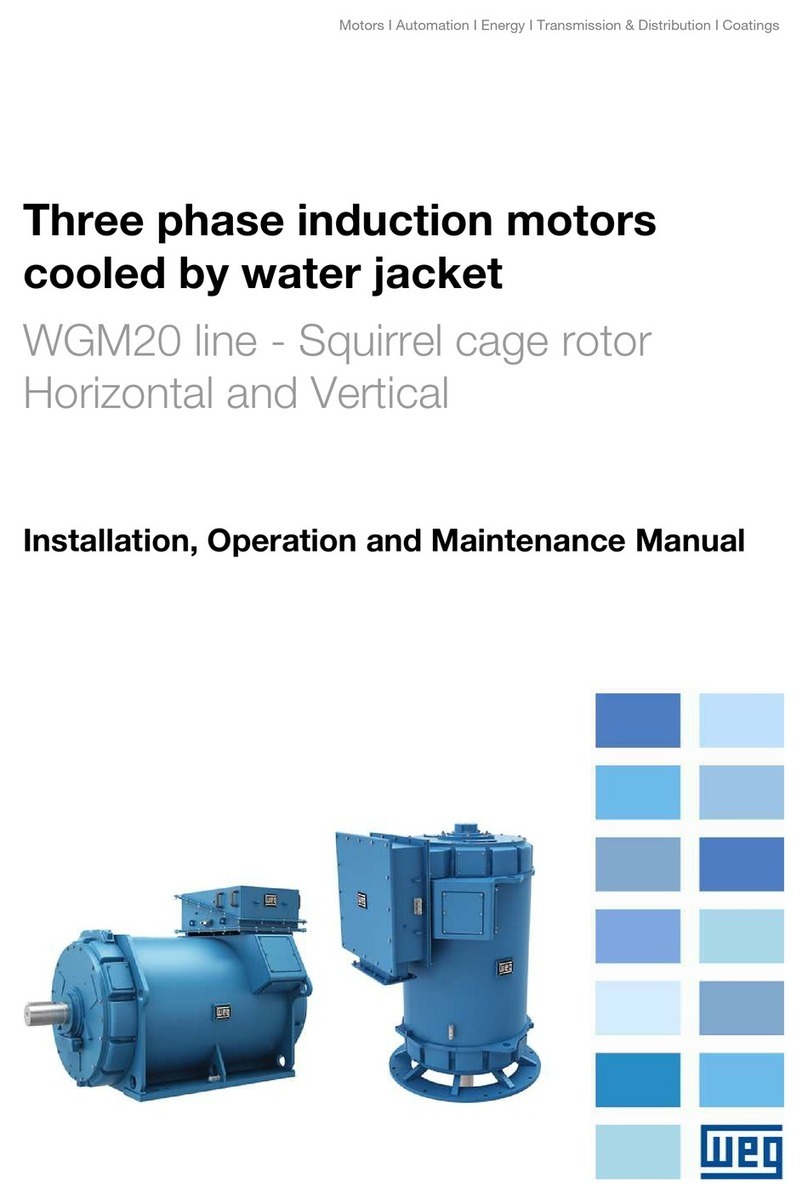
WEG
WEG WGM20 Series Installation, operation & manintenance manual
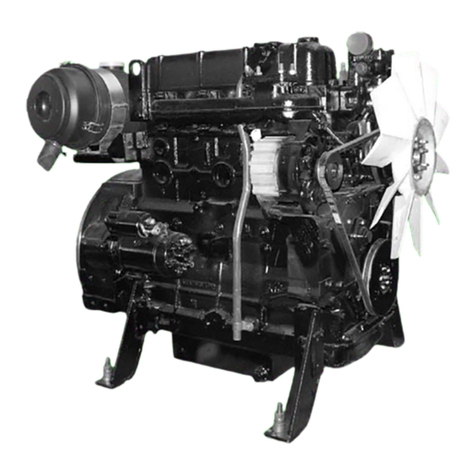
KIRLOSKAR
KIRLOSKAR R1040 Operation & maintenance manual
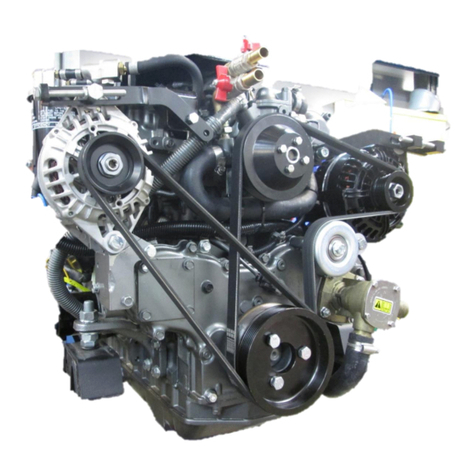
Barrus
Barrus 4JH57 manual

DR
DR R100 Safety and operating instructions
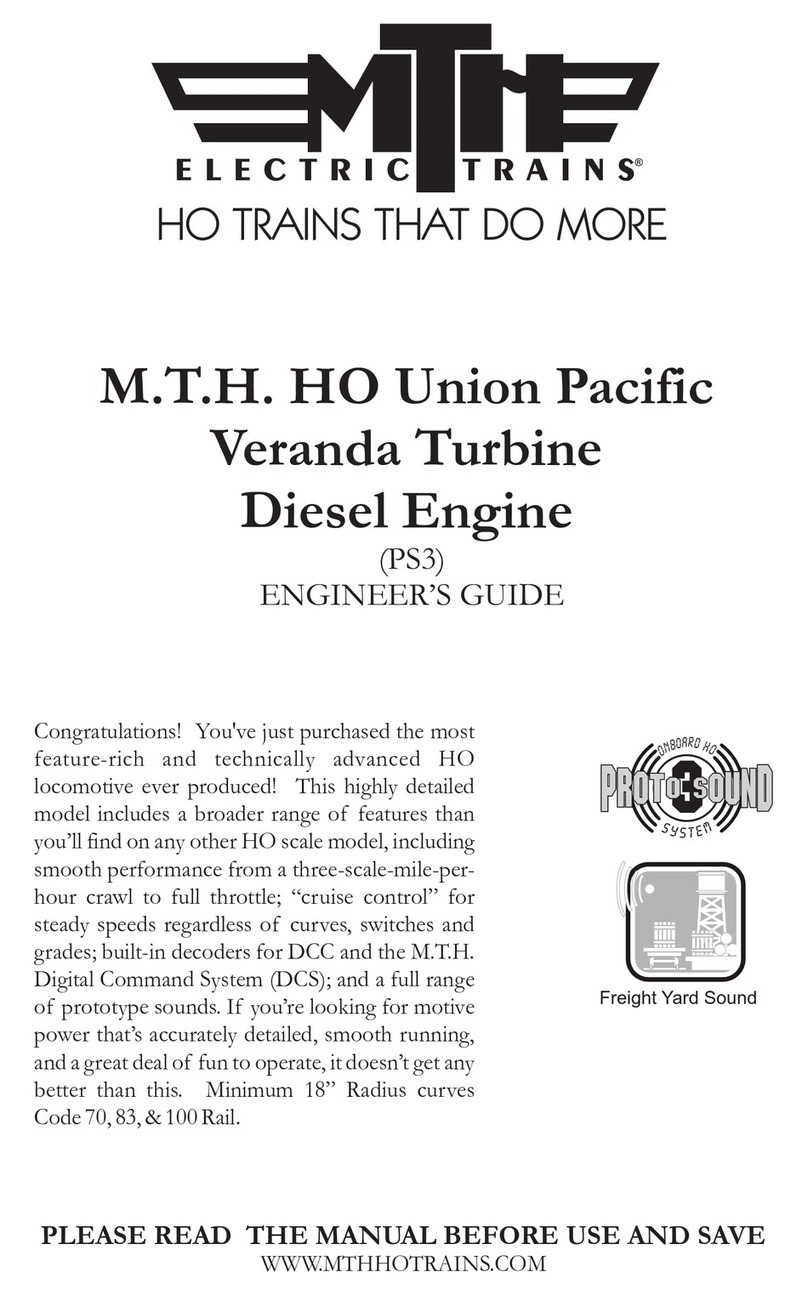
MTHTrains
MTHTrains HO Union Pacific Engineer's guide

Briggs & Stratton
Briggs & Stratton 124L00 Series Illustrated parts list
